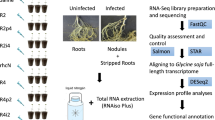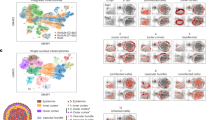Abstract
The diversity of stem-associated bacteria of non-nodulated (Nod−), wild-type nodulated (Nod+) and hypernodulated (Nod++) soybeans were evaluated by clone library analyses of the 16S ribosomal RNA gene. Soybeans were dressed with standard nitrogen (SN) fertilization (15 kg N ha–1) and heavy nitrogen (HN) fertilization (615 kg N ha–1). The relative abundance of Alphaproteobacteria in Nod+ soybeans (66%) was smaller than that in Nod− and Nod++ soybeans (75–76%) under SN fertilization, whereas that of Gammaproteobacteria showed the opposite pattern (23% in Nod+ and 12–16% in Nod− and Nod++ soybeans). Principal coordinate analysis showed that the bacterial communities of Nod− and Nod++ soybeans were more similar to each other than to that of Nod+ soybeans under SN fertilization. HN fertilization increased the relative abundance of Gammaproteobacteria in all nodulation phenotypes (33–57%) and caused drastic shifts of the bacterial community. The clustering analyses identified a subset of operational taxonomic units (OTUs) at the species level in Alpha- and Gammaproteobacteria responding to both the nodulation phenotypes and nitrogen fertilization levels. Meanwhile, the abundance of Betaproteobacteria was relatively constant in all libraries constructed under these environmental conditions. The relative abundances of two OTUs in Alphaproteobacteria (Aurantimonas sp. and Methylobacterium sp.) were especially sensitive to nodulation phenotype and were drastically decreased under HN fertilization. These results suggested that a subpopulation of proteobacteria in soybeans is controlled in a similar manner through both the regulation systems of plant–rhizobia symbiosis and the nitrogen signaling pathway in plants.
Similar content being viewed by others
Log in or create a free account to read this content
Gain free access to this article, as well as selected content from this journal and more on nature.com
or
References
Akao S, Kouchi H . (1989). A supernodulating mutant isolated from soybean cultivar Enrei. Soil Sci Plant Nutr 38: 183–187.
Altschul SF, Gish W, Miller W, Myers EW, Lipman DJ . (1990). Basic local alignment search tool. J Mol Biol 215: 403–410.
Ashelford KE, Chuzhanova NA, Fry JC, Jones AJ, Weightman AJ . (2006). New screening software shows that most recent large 16S rRNA gene clone libraries contain chimeras. Appl Environ Microbiol 72: 5734–5741.
Barbulova A, Rogato A, D′Apuzzo E, Omrane S, Chiurazzi M . (2007). Differential effects of combined N sources on early steps of the Nod factor-dependent transduction pathway in Lotus japonicus. Mol Plant Microbe Interact 20: 994–1003.
Caba JM, Centeno ML, Fernández B, Gresshoff PM, Ligero F . (2000). Inoculation and nitrate alter phytohormone levels in soybean roots: differences between a supernodulating mutant and the wild type. Planta 211: 98–104.
Carroll BJ, McNeil DL, Gresshoff PM . (1985). Isolation and properties of soybean [Glycine max (L.) Merr.] mutants that nodulate in the presence of high nitrate concentrations. Proc Natl Acad Sci USA 82: 4162–4166.
Corpe WA . (1985). A method for detecting methylotrophic bacteria on solid surfaces. J Microbiol Methods 3: 215–221.
Corpe WA, Basil DV . (1982). Methanol-utilizing bacteria, associated wit green plants. Dev Indust Microbiol 23: 483–493.
Denner EBM, Smith GW, Busse H-J, Schumann P, Narzt T, Polson SW et al. (2003). Aurantimonas coralicida gen, nov., sp. nov., the causative agent of white plague type II on Caribbean scleractinian corals. Int J Syst Evol Microbiol 53: 1115–1122.
Ewing B, Green P . (1998). Base-calling of automated sequencer traces using Phred. II. Error probabilities. Genome Res 8: 186–194.
Ewing B, Hillier L, Wendl MC, Green P . (1998). Base-calling of automated sequencer traces using Phred. I. Accuracy assessment. Genome Res 8: 175–185.
Fehr RW, Caviness CE, Burmood DT, Pennington JS . (1971). Stage of development descriptions for soybeans, Glycine max (L.) Merrill. Crop Sci 11: 929–931.
Felsenstein J . (1985). Confidence limits on phylogenies: an approach using the bootstrap. Evolution 39: 783–791.
Francisco PB, Akao S . (1993). Autoregulation and nitrate inhibition of nodule formation in soybean cv. Enrei and its nodulation mutants. J Exp Bot 44: 547–553.
Good IJ . (1953). The population frequencies of species and the estimation of population parameters. Biometrika 40: 237–264.
Gupta RS, Mok A . (2007). Phylogenomics and signature proteins for alpha proteobacteria and its main groups. BMC Microbiol 7: 106.
Hardoim PR, Van Overbeek LS, Van Elsas JD . (2008). Properties of bacterial endophytes and their proposed role in plant growth. Trends Microbiol 16: 463–471.
Harrison MJ . (2005). Signaling in the arbuscular mycorrhizal symbiosis. Annu Rev Microbiol 59: 19–42.
Ikeda S, Kaneko T, Okubo T, Rallos EEL, Eda S, Mitsui H et al. (2009). Development of a bacterial cell enrichment method and its application to the community analysis in soybean stems. Microb Ecol 58: 703–714.
Ikeda S, Rallos LEE, Okubo T, Eda S, Inaba S, Mitsui H et al. (2008a). Microbial community analysis of field-grown soybeans with different nodulation phenotypes. Appl Environ Microbiol 74: 5704–5709.
Ikeda S, Tsurumaru H, Wakai S, Noritake C, Fujishiro K, Akasaka M et al. (2008b). Evaluation of the effects of different additives in improving the DNA extraction yield and quality from Andosol. Microbes Environ 23: 159–166.
Kato Y, Asahara M, Arai D, Goto K, Yokota A . (2005). Reclassification of Methylobacterium chloromethanicum and Methylobacterium dichloromethanicum as later subjective synonyms of Methylobacterium extorquens and of Methylobacterium lusitanum as a later subjective synonym of Methylobacterium rhodesianum. J Gen Appl Microbiol 51: 287–299.
Kemp PF, Aller JY . (2004). Bacterial diversity in aquatic and other environments: what 16S rDNA libraries can tell us. FEMS Microbiol Ecol 47: 161–177.
Kinkema M, Gresshoff PM . (2008). Investigation of downstream signals of the soybean autoregulation of nodulation receptor kinase GmNARK. Mol Plant Microbe Interact 21: 1337–1348.
Kuklinsky-Sobral J, Araujo WL, Mendes R, Geraldi IO, Pizzirani-Kleiner AA, Azevedo JL . (2004). Isolation and characterization of soybean-associated bacteria and their potential for plant growth promotion. Environ Microbiol 6: 1244–1251.
Lane DJ . (1991). 16S/23S rRNA sequencing. In: Stackebrandt E, Goodfellow M (eds). Nucleic Acid Techniques in Bacterial Systematics. John Wiley & Sons Ltd. pp 115–175.
Liu J, Maldonado-Mendoza I, Lopez-Meyer M, Cheung F, Town CD, Harrison MJ . (2007). Arbuscular mycorrhizal symbiosis is accompanied by local and systemic alterations in gene expression and an increase in disease resistance in the shoots. Plant J 50: 529–544.
Lozupone C, Knight R . (2005). UniFrac: a new phylogenetic method for comparing microbial communities. Appl Environ Microbiol 71: 8228–8235.
Mano H, Tanaka F, Nakamura C, Kaga H, Morisaki H . (2007). Culturable endophytic bacterial flora of the maturing leaves and roots of rice plants (Oryza sativa) cultivated in a paddy field. Microbes Environ 22: 175–185.
Matsunami T, Kaihatsu A, Maekawa T, Takahashi M, Kokubun M . (2004). Characterization of vegetative growth of a supernodulating soybean genotype, Sakukei 4. Plant Prod Sci 7: 165–171.
Meixner C, Vegvari G, Ludwig-Müller J, Gagnon H, Steinkellner S, Staehelin C et al. (2007). Two defined alleles of the LRR receptor kinase GmNARK in supernodulating soybean govern differing autoregulation of mycorrhization. Physiologia Plantarum 130: 261–270.
Nishimura R, Hayashi M, Wu G, Kouchi H, Imaizumi-Anraku H, Murakami Y et al. (2002). HAR1 mediates systemic regulation of symbiotic organ development. Nature 420: 426–429.
Offre P, Pivato B, Siblot S, Gamalero E, Corberand T, Lemanceau P et al. (2007). Identification of bacterial groups preferentially associated with mycorrhizal roots of Medicago truncatula. Appl Environ Microbiol 73: 913–921.
Oka-Kira E, Kawaguchi M . (2006). Long-distance signaling to control root nodule number. Curr Opin Plant Biol 9: 496–502.
Okamoto S, Ohnishi E, Sato S, Takahashi H, Nakazono M, Tabata S et al. (2009). Nod factor/nitrate-induced CLE genes that drive HAR1-mediated systemic regulation of nodulation. Plant Cell Physiol 50: 67–77.
Okubo T, Ikeda S, Kaneko T, Eda S, Mitsui H, Sato S et al. (2009). Nodulation-dependent communities of culturable bacterial endophytes from stems of field-grown soybeans. Microbes Environ 24: 253–258.
Page RDM . (1996). TreeView: an application to display phylogenetic trees on personal computers. Bioinformatics 12: 357–358.
Parniske M . (2000). Intracellular accommodation of microbes by plants: a common developmental program for symbiosis and disease? Curr Opin Plant Biol 3: 320–328.
Radutoiu S, Madsen LH, Madsen EB, Felle HH, Umehara Y, Gronlund M et al. (2003). Plant recognition of symbiotic bacteria requires two LysM receptor-like kinases. Nature 425: 585–592.
Saito A, Ikeda S, Ezura H, Minamisawa K . (2007). Microbial community analysis of the phytosphere using culture-independent methodologies. Microbes Environ. 22: 93–105.
Saitou N, Nei M . (1987). The neighbor-joining method: a new method for reconstructing phylogenetic trees. Mol Biol Evol 4: 406–425.
Schloss PD, Handelsman J . (2005). Introducing DOTUR, a computer program for defining operational taxonomic units and estimating species richness. Appl Environ Microbiol 71: 1501–1506.
Schloss PD, Handelsman J . (2006). Introducing SONS, a tool for operational taxonomic unit-based comparisons of microbial community memberships and structures. Appl Environ Microbiol 72: 6773–6779.
Searle IR, Men AE, Laniya TS, Buzas DM, Iturbe-Ormaetxe I, Carroll BJ et al. (2003). Long-distance signaling in nodulation directed by a CLAVATA1-like receptor kinase. Science 299: 109–112.
Stacey G, Libault M, Brechenmacher L, Wan J, May GD . (2006). Genetics and functional genomics of legume nodulation. Curr Opin Plant Biol 9: 110–121.
Thompson JD, Higgins DG, Gibson TJ . (1994). CLUSTAL W: Improving the sensitivity of progressive multiple sequence alignment through sequence weighting, position-specific gap penalties and weight matrix choice. Nucleic Acids Res 22: 4673–4680.
Wang Q, Garrity GM, Tiedje JM, Cole JR . (2007). Naive Bayesian classifier for rapid assignment of rRNA sequences into the new bacterial taxonomy. Appl Environ Microbiol 73: 5261–5267.
Weon H-Y, Kim B-Y, Yoo S-H, Joa J-H, Lee KH, Zhang Y-S Z et al. (2007). Aurantimonas ureilytica sp. nov., isolated from an air sample. Int J Syst Evol Microbiol 57: 1717–1720.
Zhou J, Xia B, Treves DS, Wu LY, Marsh TL, O’Neill RV et al. (2002). Spatial and resource factors influencing high microbial diversity in soil. Appl Environ Microbiol 68: 326–334.
Acknowledgements
We thank M. Kokubun (Tohoku University) for providing the soybean seeds. This work was supported in part by Special Coordination Funds for Promoting Science and Technology and in part by a Grant-in-Aid for Scientific Research on Priority Areas ‘Comparative Genomics’ from the Ministry of Education, Culture, Sports, Science and Technology of Japan, and in part by a grant from the Ministry of Agriculture, Forestry and Fisheries of Japan (Genomics for Agricultural Innovation, PMI-0002).
Author information
Authors and Affiliations
Corresponding author
Additional information
Supplementary Information accompanies the paper on The ISME Journal website (http://www.nature.com/ismej)
Rights and permissions
About this article
Cite this article
Ikeda, S., Okubo, T., Kaneko, T. et al. Community shifts of soybean stem-associated bacteria responding to different nodulation phenotypes and N levels. ISME J 4, 315–326 (2010). https://doi.org/10.1038/ismej.2009.119
Received:
Revised:
Accepted:
Published:
Issue date:
DOI: https://doi.org/10.1038/ismej.2009.119
Keywords
This article is cited by
-
Plant organ- and growth stage-diversity of endophytic bacteria with potential as biofertilisers isolated from wheat (Triticum aestivum L.)
BMC Plant Biology (2022)
-
Plant Compartments and Developmental Stages Modulate the Balance between Niche-Based and Neutral Processes in Soybean Microbiome
Microbial Ecology (2021)
-
Endophytic microbes: biodiversity, plant growth-promoting mechanisms and potential applications for agricultural sustainability
Antonie van Leeuwenhoek (2020)
-
Genetic diversity of indigenous soybean-nodulating Bradyrhizobium elkanii from southern Japan and Nueva Ecija, Philippines
Plant and Soil (2017)
-
Composition and activity of endophytic bacterial communities in field-grown maize plants inoculated with Azospirillum brasilense
Annals of Microbiology (2015)



